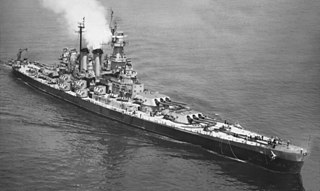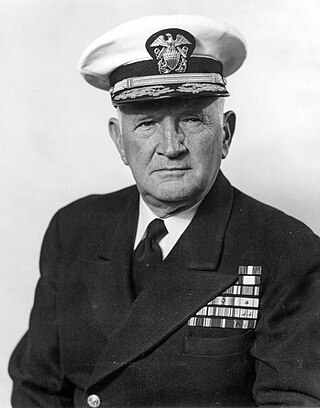
The Battle of Leyte Gulf 23–26 October 1944, was the largest naval battle of World War II and by some criteria the largest naval battle in history, with over 200,000 naval personnel involved.

USS Alabama (BB-60) is a retired battleship. She was the fourth and final member of the South Dakota class of fast battleships built for the United States Navy in the 1940s. The first American battleships designed after the Washington Treaty system began to break down in the mid-1930s, they took advantage of an escalator clause that allowed increasing the main battery to 16-inch (406 mm) guns, but Congressional refusal to authorize larger battleships kept their displacement close to the Washington limit of 35,000 long tons (36,000 t). A requirement to be armored against the same caliber of guns as they carried, combined with the displacement restriction, resulted in cramped ships. Overcrowding was exacerbated by wartime modifications that considerably strengthened their anti-aircraft batteries and significantly increased their crews.

USS North Carolina (BB-55) is the lead ship of the North Carolina class of fast battleships, the first vessel of the type built for the United States Navy. Built under the Washington Treaty system, North Carolina's design was limited in displacement and armament, though the United States used a clause in the Second London Naval Treaty to increase the main battery from the original armament of twelve 14-inch (356 mm) guns in quadruple turrets to nine 16 in (406 mm) guns in triple turrets. The ship was laid down in 1937 and completed in April 1941, while the United States was still neutral during World War II.

USS Massachusetts (BB-59) is the third of four South Dakota-class fast battleships built for the United States Navy in the late 1930s. The first American battleships designed after the Washington treaty system began to break down in the mid-1930s, they took advantage of an escalator clause that allowed increasing the main battery to 16-inch (406 mm) guns, but refusal to authorize larger battleships kept their displacement close to the Washington limit of 35,000 long tons (36,000 t). A requirement to be armored against the same caliber of guns as they carried, combined with the displacement restriction, resulted in cramped ships, a problem that was exacerbated by wartime modifications that considerably strengthened their anti-aircraft batteries and significantly increased their crews.

Task Force 16 was one of the most storied task forces in the United States Navy, a major participant in a number of the most important battles of the Pacific War.

USS South Dakota (BB-57) was the lead vessel of the four South Dakota-class fast battleships built for the United States Navy in the 1930s. The first American battleships designed after the Washington treaty system began to break down in the mid-1930s, the South Dakotas were able to take advantage of a treaty clause that allowed them to increase the main battery to 16-inch (406 mm) guns. However, congressional refusal to authorize larger battleships kept their displacement close to the Washington limit of 35,000 long tons (35,562 t). A requirement to be armored against the same caliber of guns as they carried, combined with the displacement restriction, resulted in cramped ships. Overcrowding was exacerbated by wartime modifications that considerably strengthened their anti-aircraft batteries and significantly increased their crews.

USS Washington (BB-56) was the second and final member of the North Carolina class of fast battleships, the first vessel of the type built for the United States Navy. Built under the Washington Treaty system, North Carolina's design was limited in displacement and armament, though the United States used a clause in the Second London Naval Treaty to increase the main battery from the original armament of nine 14 in (356 mm) guns to nine 16 in (406 mm) guns. The ship was laid down in 1938 and completed in May 1941, while the United States was still neutral during World War II. Her initial career was spent training along the East Coast of the United States until Japan attacked Pearl Harbor on 7 December 1941, bringing the United States into the war.

The Fast Carrier Task Force was a group of ships in World War II. It was the main striking force of the United States Navy in the Pacific War from January 1944 through the end of the war in September 1945. The task force was made up of several separate task groups, each typically built around three to four aircraft carriers and their supporting vessels. The support vessels were screening destroyers, cruisers, and the newly built fast battleships.

USS St. Louis, eighth of nine Brooklyn-class light cruisers, was the fifth ship of the United States Navy named after the city of St. Louis, Missouri. Commissioned in 1939, she was very active in the Pacific during World War II, earning eleven battle stars.

USS Wichita was a unique heavy cruiser of the United States Navy built in the 1930s. The last American cruiser designed to meet the limits of the London Naval Treaty, she was originally intended to be a New Orleans-class heavy cruiser, accordingly with the maximum main armament of three triple 8-inch (203 mm) gun turrets. These were instead placed on an improved hull derived from the Brooklyn-class light cruisers, with increased armor. This design would go on to form the basis for the later World War II–era heavy cruisers such as the Baltimore class. The ship was authorized by the 1929 Cruiser Act, laid down at the Philadelphia Naval Shipyard in October 1935, launched in November 1937, and commissioned into the US Navy in February 1939.

Jesse Barrett "Oley" Oldendorf was an admiral in the United States Navy, famous for defeating a Japanese force in the Battle of Leyte Gulf during World War II. He also served as commander of the American naval forces during the early phase of the Battle of the Caribbean. In early 1942, a secret group of senior Navy officers empaneled by President Franklin D. Roosevelt assessed him as one of the 40 most competent of the 120 flag officers in the Navy.

USS Miami was a Cleveland-class light cruiser of the United States Navy, which were built during World War II. The class was designed as a development of the earlier Brooklyn-class cruisers, the size of which had been limited by the First London Naval Treaty. The start of the war led to the dissolution of the treaty system, but the dramatic need for new vessels precluded a new design, so the Clevelands used the same hull as their predecessors, but were significantly heavier. The Clevelands carried a main battery of twelve 6-inch (152 mm) guns in four three-gun turrets, along with a secondary armament of twelve 5 in (127 mm) dual-purpose guns. They had a top speed of 32.5 knots.

USS Minneapolis (CL/CA-36) was a New Orleans-class cruiser built for the United States Navy before the outbreak of World War II, the second ship named for Minneapolis, Minnesota. She served in the Pacific Theater during World War II.

Thomas Cassin Kinkaid was an admiral in the United States Navy, known for his service during World War II. He built a reputation as a "fighting admiral" in the aircraft carrier battles of 1942 and commanded the Allied forces in the Aleutian Islands Campaign. He was Commander Allied Naval Forces and the Seventh Fleet under General of the Army Douglas MacArthur in the Southwest Pacific Area, where he conducted numerous amphibious operations, and commanded an Allied fleet during the Battle of Leyte Gulf, the largest naval battle of World War II and the last naval battle between battleships in history.

USS Wedderburn (DD-684), was a Fletcher-class destroyer of the United States Navy.

USS Bagley (DD-386), a Bagley-class destroyer, was the third ship of the United States Navy to be named for Ensign Worth Bagley, officer during the Spanish–American War, distinguished as the only U.S. naval officer killed in action during that war.

USS Marshall (DD-676) was a Fletcher-class destroyer of the United States Navy.

USS Porterfield (DD-682) was a Fletcher-class destroyer of the United States Navy. Commissioned in 1943, she served in several Pacific campaigns during World War II, earning ten battle stars. She was decommissioned immediately after the end of the war but reactivated in 1951 for the Korean War, earning four more battle stars, and then served continuously until 1969. She was sunk as a target in 1982.

USS Monssen (DD-798) was a Fletcher-class destroyer of the United States Navy, the second Navy ship named for Lieutenant Mons Monssen (1867–1930), who was awarded the Medal of Honor for putting out a fire in a magazine on Missouri.



















